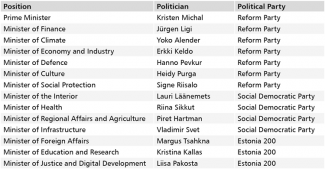Estonia: Michal forms an anti-crisis cabinet
On 23 July, the Estonian parliament granted a vote of confidence to the cabinet led by Kristen Michal of the Reform Party. The new government was formed after former Prime Minister Kaja Kallas was nominated as the EU High Representative for Foreign Affairs and Security Policy. The government coalition, which has been in power since 2023, will once again include the Reform Party, Estonia 200, and the Social Democratic Party (SDE). The Reform Party will oversee six ministries, the Social Democrats will control four ministries, including the newly created Ministry of Infrastructure, and the liberals from Estonia 200 will continue to control three ministries, with five new ministers joining the cabinet. The coalition holds 59 seats in the 101-member Riigikogu (see the Appendix for the cabinet’s composition).
The coalition agreement of 19 July includes plans to reform public finances, particularly the tax system. The new government’s flagship project is the introduction of a defence tax from 2026, comprising a 2% turnover tax and a 2% personal and corporate income tax. The plan also includes budget spending cuts, the privatisation of state-owned enterprises, and raising excise duties. The proposed budget savings will not affect pensions or the funds allocated to the police, border guard, and armed forces.
Commentary
- The most important task for the Michal cabinet is to stabilise the economic and social situation in the country. In the first quarter of 2024, the economy shrank by 2.1%, and the unemployment rate stood at 7.8%. Compared to other Baltic economies, Estonia is stabilising at a much slower rate and is likely to return to growth only next year. The Estonian public, already weary of the previous government’s attempts to impose new taxes, is expected to resist the austerity measures announced by the new cabinet. The new cabinet will continue the foreign and security policies adopted by its predecessor, meaning Estonia will remain a stable partner within NATO and the EU. The fact that Margus Tsahkna and Hanno Pevkur will continue to serve as Minister of Foreign Affairs and Minister of Defence, respectively, is seen as a guarantee of maintaining this course. The level of defence spending will also remain unchanged at approximately 3% of GDP and may even be raised in the coming years.
- The replacement of the prime minister is unlikely to ease the strained situation inside the government. If disagreements between the coalition partners persist, some points of the coalition agreement may never be implemented. The Social Democrats might find it increasingly difficult to accept some of the liberal solutions proposed by the Reform Party and Estonia 200. Additionally, the SDE is set to emphasise its social agenda more strongly and criticise its coalition partners for their liberal economic reforms. However, given the current parliament composition, no alternative majority can be formed, so the SDE is unlikely to leave the coalition. No snap elections have been held in Estonia so far, and the next parliamentary election is scheduled for March 2027.
- The greatest challenge for the new prime minister and leader of the Reform Party will be to regain some of their base. The party’s ratings have been falling since the parliamentary elections in March 2023 and it currently ranks third in the polls with about 15–17% support, down from 31% in the previous election. Reversing this downward trend may prove difficult for two reasons: firstly, Estonians are dissatisfied with the government’s performance, including economic stagnation, and secondly, the traditional narrative of the Reform Party, which primarily focuses on economic development and opposition to populist slogans, is gradually losing its appeal. Populist parties, such as the Centre Party and the Estonian Conservative People’s Party, are waning in influence, while mainstream parties–the right-wing Isamaa and the Social Democratic Party–are gaining support in the polls. Isamaa has been leading the polls for several months, while the Social Democrats are competing for second place. This shift adversely affects the Reform Party, which until recently could capitalise on social and political polarisation.
APPENDIX
The composition of Kristen Michal’s cabinet






